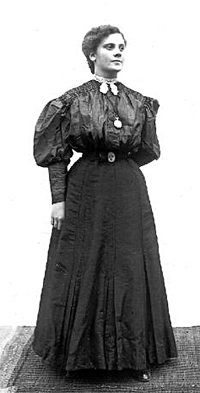|
| Coming
of Age as a Female in Turn-of-the-Century Illinois
Comparing Fiction
and Primary Sources
 This lesson explores
the roles of females in the family and in society by comparing the pictorial
lives of Mary and Phoebe Sadorus in the Sadorus Photograph Collection
and the fictional live of the characters Euterpe, Adelaide, Lottie, and Rosie
in Richard Peck's novel Fair Weather. The setting of the
novel is within 50 miles of the Sadorus farm and the time frame, 1893,
is only a decade earlier.
Left: Mary Sadorus
Objective:
Students will be able to collect, compare, and discuss information about
the social system and its changes from these sources and others, making
inferences, assertions, and arguments about them in the lives of the
people and characters.
Grade Level: Early High School, Late High School
Time Required: Students will read the novel and discuss and make
notes on the female characters. Students will examine the Sadorus
Collection photos looking for clues about the lives of the women and discuss
these same topics. Then students will research other print and Web resources
on turn-of-the-century rural and urban life in the Midwest to find facts that support
or refute what they have found in the novel and the photograph
collection.
Students will
read the novel, discussing and making notes on the female characters
about the topics of female choices and opportunities regarding:
Role in the family
Marriage
Jobs
Role in society
Rural vs. urban society and roles
Economic independence
Education
Questions to
guide study and discussion:
1. Growing up and becoming ladylike was often mentioned by Rosie and
was a theme of the novel. How is leaving childhood things behind scary
and exciting at the same time? How did this affect Lottie? Rosie? Looking
back over her life, how had it affected Adelaide? Euterpe? Any regrets?
Why do you think Adelaide refused to go on the trip to Chicago?
2. How did the novel's female characters (Lottie and Rosie) 'improve'
their lives compared to the previous generation's characters (Euterpe
and Adelaide)?
3. What choices might Lottie have had if she had stayed on the farm?
Was it common for young rural women to move to the cities? How might
life have been different for Mary Sadorus when she moved to town after
the farm was sold?
4. What choices might Mary Sadorus have had or not had for education,
marriage, and economic independence?
5. How was Mary Sadorus' life different from or similar to her mother's?
6. What changes in technology would alter the lives of women at the
turn of the century?
7. In the novel, were the opportunities Euterpe thought she had in the
city any wider than those she thought the girls had in the country?
How had the death of her husband revealed Euterpe's lack of coping skills?
How did the girls, with their younger attitudes and lack of social inhibitions,
help Euterpe see new opportunities for herself?
8. Describe the difference in attitudes toward people and society that
Grandpa and Euterpe displayed? How much could be attributed to their
gender roles? How much to their upbringing and life experience?
9. What prejudices did rural people seem to have about the people of
Chicago? What prejudices did the residents of Chicago have about rural
people? Were these perceptions true? How different were the two sets
of people? In what ways?
10. How realistic is the plot and denouement of the novel? Why?
ISBE Standards
for Social Studies:
Early High School: 18.A.4 Analyze the influence of cultural factors
including customs, traditions, language, media, art and architecture
in developing pluralistic societies.
Late High School: 18.A.5 Compare ways in which social systems
are affected by political, environmental, economic and technological
changes.
Literature:
Early High School:
2.B.4b Analyze form, content, purpose, and major themes of American
literature (and literature of other countries) in their historical perspectives.
(Identify the major themes in Fair Weather.)
2.B.4c Discuss and evaluate motive, resulting behavior, and consequences
demonstrated in literature. (Evaluate the motives of the characters
in Fair Weather and compare them with the actual motives, actions and
consequences of the Sadorus women)
Late High School: 2.B.5b Apply knowledge gained from literature
as a means of understanding contemporary and historical economic, social
and political issues and perspectives. (What were the issues addressed
in the novel? How were they addressed? How were they addressed in the
lives of the Sadorus family members?)
|

